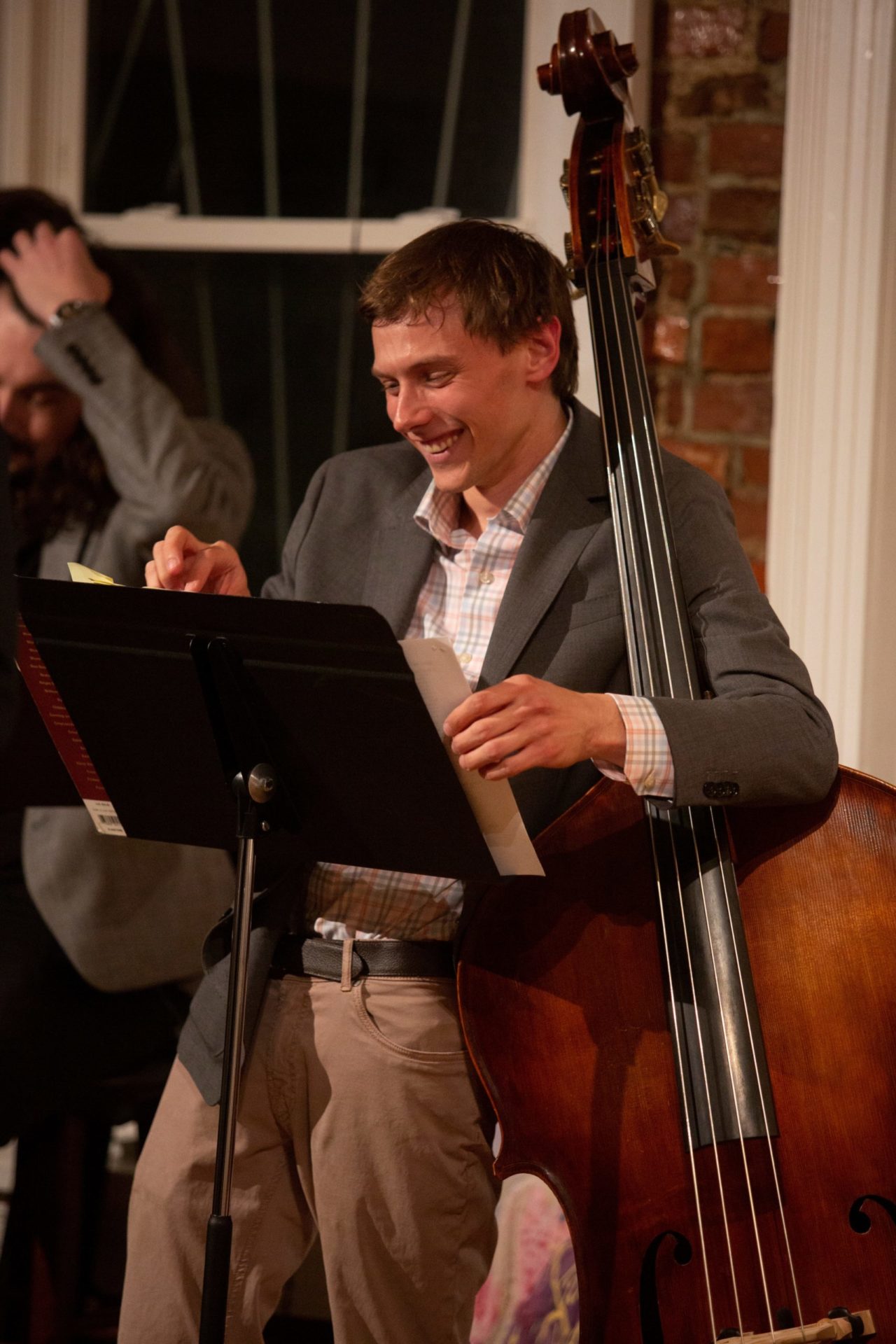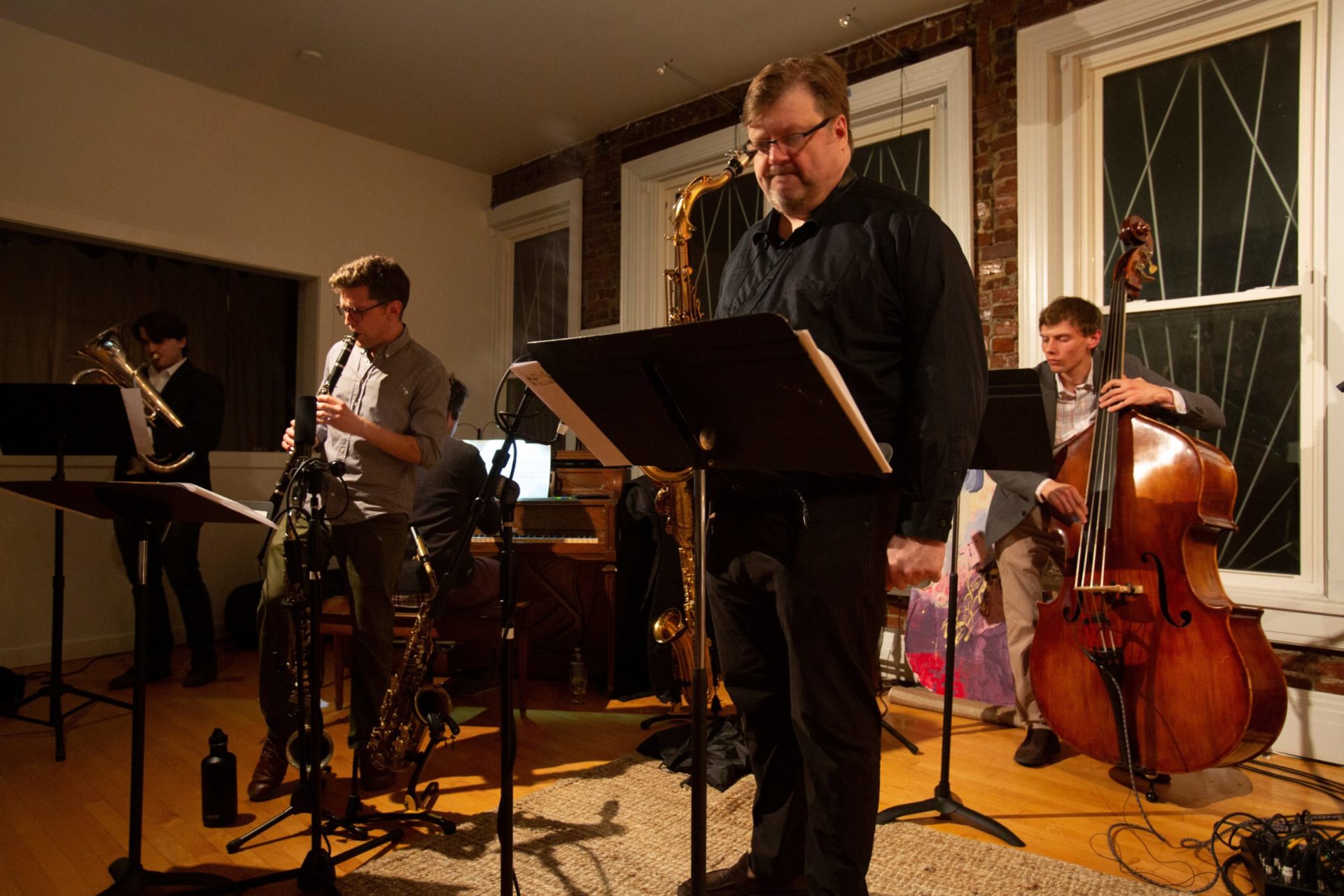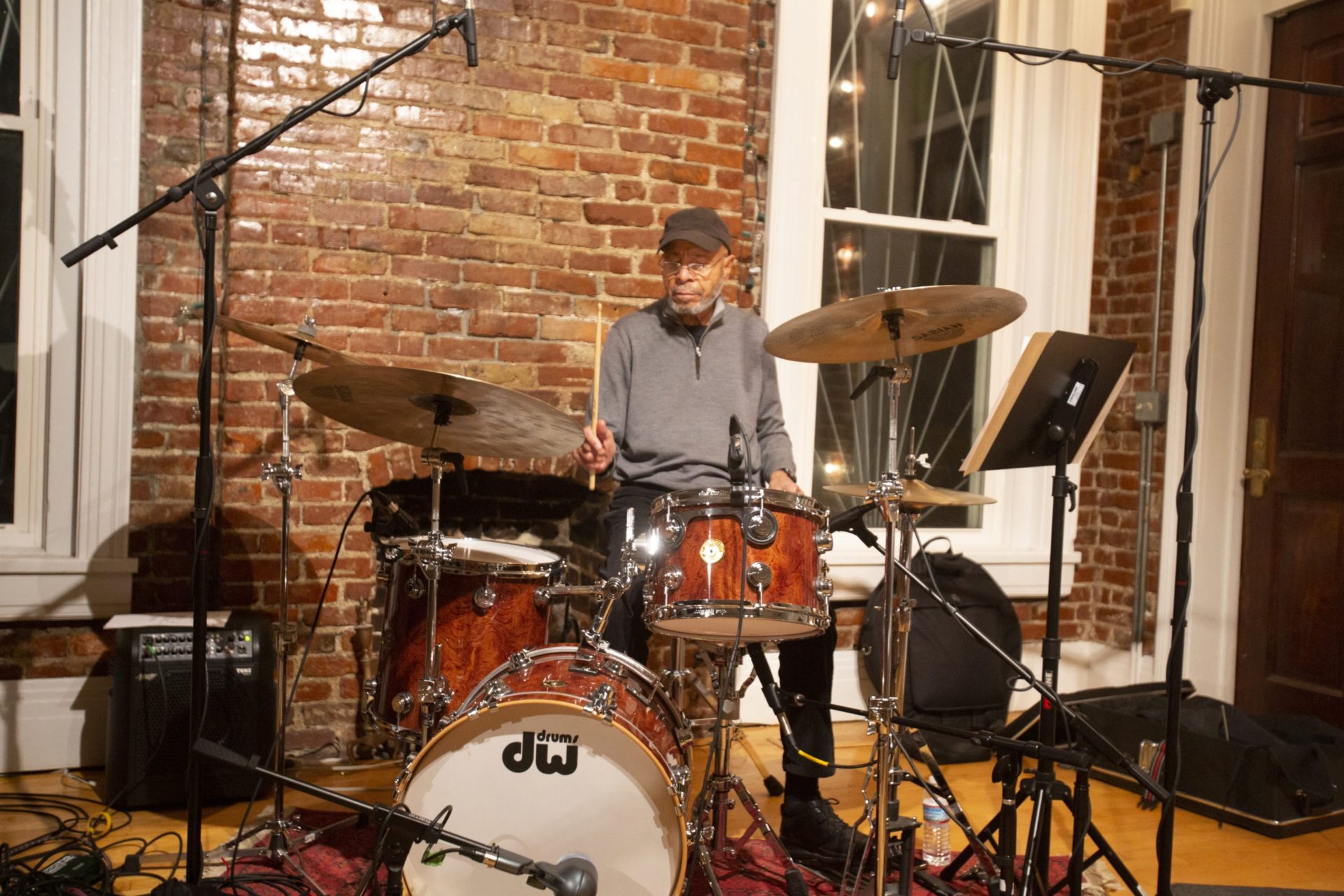New in the Music City:
Blueprint & Jacob Jezioro at the Axiom Art Gallery
Nobody would blame you for missing the Axiom Art Gallery. Tucked away between Third Man Records and the Plaza art supplies store, the only signage in front of the building reads “Resident Parking Only.” It’s just as well, because the space in front of the vintage building that houses the Axiom Art Gallery leaves only enough room for a handful of cars. Fortunately, even on a Saturday night, this little elbow-shaped stretch of Seventh Avenue is quiet, either forgotten or yet-to-be-discovered compared to the hustle and bustle of the Gulch just a block or two to the West. So, you might have to hike a little, but parking’s no problem. The building has a wraparound porch and a number of large wooden doors, most of which apparently lead to private apartments. Tonight however, there were no issues figuring out which of the doors housed the art gallery. The swish of brushes on a snare drum and the probing sounds of a soloing tenor sax wafted out faintly from the front right door—exactly the sort of welcome you’d hope to get from a low-key event like this.

An event so low-key, in fact, I’m not even positive what to call it. The concert had a neat hand-painted poster floating around Twitter that featured a few ghostly-looking cats and dogs, one of the cats smiling pleasantly, the other with evil eyes and its claws poised threateningly. “Music to Ease Our [revolutionary] Minds” the poster reads with nothing else but a time and place. I never figured out if this was supposed to be the title or the subtitle of the evening, but I guess that ambiguity is the point. The words on the poster aren’t so much a title—a what this concert is supposed to be—but rather a description—a why make this music in the first place. And while I can’t say I ever pieced together the explicit political meaning of “Music to Ease Our [revolutionary] Minds,” I think getting caught up there misses the point. To give the performance a title and an explicit program would fix it in place and time. It would turn the living, breathing organism of structured, simultaneous improvisation into a fossilized museum piece completely out of the spirit of the whole affair. In other words, we have to understand music here not as a noun but as a verb. At one point in the night, right at the start of the second set, there was a bit of confusion as to which piece should go next. Performers and lead sheets were shuffled around the room as Jacob Jezioro, the force behind organizing the whole thing and the composer of a number of the works performed, conferred back and forth with his band. Finally, when things settled into place, Jezioro cried out “That’s jazz! That’s jazz everybody!”
You see that same spirit of improvisation in the putting-together of the whole concert too. Though Jezioro was the center of the evening, he shares the billing with Nashville’s Blueprint Ensemble, a relatively new ensemble looking to “[map] out the future of Art Music.” Blueprint was initially supposed to have a concert towards the beginning of March, which was unfortunately postponed. Jezioro, who was slated to play bass for Blueprint at this postponed show, suggested reworking a planned concert of his own into a collaboration—the setlist was reworked, some more members of the Blueprint Ensemble worked in, and the night was born. The performing lineup changed even more between the rebranding of the concert as a collaboration between Jezioro and the Blueprint Ensemble and the first downbeat. Chester Thompson, the legendary drummer, was apparently brought on to replace another drummer with barely a moment to spare. Sax player Joel Frahm, whose solos that night were unbelievable in their ability to thread the needle between scalar flourishes and almost-hummable tunefulness, glanced through a number of scores moments before the first set, occasionally asking Jezioro for clarification on a time signature here or an accidental there. And yet, you’d have no way of knowing. All of these musicians are Old Pros, putting together an entire evening of capital-G Great music in a way that’s hard enough to do with months of planning and the prospect of a big profit.

The Axiom Art Gallery might have housed twenty people that night all told, including the rotating group of performers, and there wasn’t much room for more. It’s a deliberately intimate space, perfectly suited to the spirit of Jezioro and the Blueprint Ensemble’s program. Most of the crowd knew each other and/or the performers, so even while you spent most of the night silent, breathlessly following another round of traded fours, there was a lovely social dimension to the proceedings. There’s nothing impersonal here. You’re making frequent eye contact with everyone, but especially the performers in a way that places you directly in the middle of the whole process. There’s no illusion that you are somehow on the outside, spectating neutrally. You get that sense that if you changed even a single thing about the setting, if even one person had decided to stay home that night, the fragile magic of the room would dissipate. Of course, it’s probably untrue, but if the Blueprint Ensemble are looking to program concerts in this space in the future, there’s certainly an opportunity to find or commission works that incorporate the audience more literally.
I think the boundary between performer and audience might be the final frontier. I said that I think we’re to understand music as a verb rather than a noun in this setting, and I think Jezioro’s program mostly achieves this. There was a dynamism to almost every aspect of this concert. Even its beginning feels less like a boundary than a suggestion, more an almost-overlookable change of atmosphere than anything else. Jezioro gave a few words of welcome and thanks to the in-person audience, but after he returned to his seat in the crowd, you would be forgiven for mistaking the beginning of Thompson’s improvised drum solo as him just testing his hi-hat. His first few hits feel almost non-metric, and the repetition of the same figure on the bass drum a few seconds later almost assures you he’s just warming up, that the real show is just about to start. And yet, just as soon as you’ve had a second to make sense of what you’ve heard, he’s moved on, now establishing more of a fixed groove, and it’s clear he’s soloing. The rest of the ensemble slowly peel off from the audience, one by one joining in. This improv gives way, again practically imperceptibly, to the first work on the setlist, a piece by Jezioro entitled Agape. It’s clear by the time David Williford is playing the tune on the clarinet that we’ve arrived at a Composition, a Text that can be said to exist in some form independently of its performance, and yet this gradual almost non-start refuses to give us that kind of certainty. It doesn’t so much reject the idea of the Text as remind us that what we call the Text isn’t something so much as it is a byproduct of performance itself, something we destroy in our attempts to contain it. Art, in other words, is something alive, and most concerts are more like a public execution.
I think there is one more dimension to the Text-ness of a work. It isn’t just a fuzziness between where one work starts and the other stops, or even the distance between the start of a work and the infinitesimal slice of silence that precedes it. Instead, like I’ve already mentioned, it’s where what’s being performed intersects with the audience there to hear it. The dynamic nature of jazz improv itself already interferes with this distinction. As anyone with even a shred of experience playing in a rhythm section knows, there’s as much moment-to-moment complexity in comping underneath a solo as there is to soloing itself. The process is necessarily interactive as jazz musicians play off one another both consciously and unconsciously in an almost intersubjective feedback loop where listening is playing and playing is listening. Therefore, to play a solo or to accompany a solo is to be both performer and audience member simultaneously, and yet, obviously, this same intersubjectivity can never really be shared by the audience. Axiom Art Gallery can make you feel like you’re sharing in it, but it’s always just right on the cusp.

Never was this tension clearer than in the performance of the only not-explicitly-jazz work of the evening: Rodney Lister’s Sestina. The piece is aleatoric and consists of dozens of pre-written sets of pitches arranged into “measures.” An ensemble of performers is free to realize these pitches at whatever rhythm feels appropriate in the moment, so long as each performer moves from “measure” to “measure” at the same time. What you end up with in performance is an interesting obversion of the usual dynamics of jazz improv, where a common pulse and the architecture of the changes unify the proceedings. Instead, here the performers are all playing the same thing (or more or less the same thing) but irrespective of pulse or harmonization. It doesn’t come across so much as heterophony as a kind of controlled, deliberate cacophony. The performers can’t listen to each other, or at least ought not to, because the only possibility of synchronization is a kind of monophony the random nature of the piece seems intent on subverting. The audience, however, must listen. You have no other choice. If any meaning, if anything Text-like, is to be found here, it must be sussed out, must be invented by the listener in real time. We’re left here with a compelling, largely unresolvable paradox. Much of the spiritual/philosophical motivation for aleatoric music (especially that of John Cage’s) was the eradication, or at least a radical de-centering, of the “authority” of the author over the text. It’s an early expression of what we’d now call post-structuralism, a term that’s only ever loosely defined, and more often than not applied to an artist, work, or school of thought rather than claimed by one. In any case, the tenets of post-structuralism have found far more purchase in writings about music (including my own) than in music itself. And here it’s not hard to see why. Aleatory may make delineating between Author and Text more challenging, but if anything seems to draw the distinction between performer and audience into sharp relief.
I suppose this is why I found the way the gallery was arranged for the concert to be so striking. The art in the gallery still hung on the walls, but we in the audience sat with our backs to it, the ensemble playing directly at it. Why is this, I wonder? Maybe it has to do with purely technical considerations. The event was, after all, livestreamed on YouTube (and remains available at this link: https://www.youtube.com/watch?v=ZTfCBRKhy8U), so there could have been any number of IT reasons the ensemble was on one side of the gallery and the chairs for the audience the other. But even if unintentional, I’m left wondering if the arrangement worked to keep the audience from looking at the fixed works on the wall, or if the design forced the performers to fixate on them, in some sense perform for them, in a way that confuses this whole matter for me even more.



